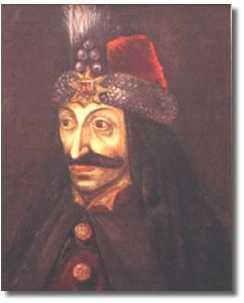Dracula, between legend and reality

Dracula or Vlad the Impaler was the son of Vlad Dracul (1436-1442; 1443-1447) and grandson of Mircea the Old (1386-1418). Vlad Dracul was dubbed a knight of the Dragon Order by the Hungarian king. All the members of the order had a dragon on their coat of arms, and that is what brought him the nickname of Dracul (the Devil). Vlad the Impaler used to sign himself Draculea or Draculya - the Devil'sDracula's renown reached the West through the Saxons from the Transylvanian towns of Brasov (Kronstadt) and Sibiu (Hermannstadt), who often gave shelter to those who claimed the Wallachian throne. In order to escape the peril of losing his throne, Vlad would punish the Saxons. Sibiu and the neighbouring area were pillaged and burnt down by Vlad, and many Saxons were impaled. The same happened to the Saxon merchants who came on business to Târgoviste.In fact, Vlad was called Tepes (the Impaler) only after his death (1476). He ruled in Wallachia between 1456-1462 and in 1476. In 1462, having been defeated by the Turks, Vlad took refuge in Hungary. In 1476, with the help of the Hungarian king Matia Corvin and the Moldavian prince Stephen the Great, Vlad took over the Wallachian throne again for a month. A battle followed, during which Vlad was killed. His body was buried in the church of the Snagov Monastery, on an island near Bucharest. His body lies in front of the altar. In 1935, a richly dressed but beheaded corpse was exhumed at Snagov, a fate known to have overtaken Dracula, whose head was supposedly wrapped, perfumed and dispatched as a gift to the Turkish sultan.They say that impalling was one of Dracula's favourite punishments, but he was not the only one who made use of it at the time. Other German and Spanish princes would do the same. He used the method for boyars, thieves and criminals, Turks, Saxons and those who conspired against him; more than once it happened that a whole forest of sharp stakes with enemies' heads would rise around Târgoviste, the capital of Wallachia at the time.Horrified by these atrocities, the Saxons printed books and pamphlets in which they told about Vlad's cruelty. These booklets also reached Germany and Western Europe, where Dracula became known as a bloody tyrant.In 1897, the Irish writer Bram Stoker published Dracula, which made Vlad the Impaler famous world-wide. Stoker read the stories about Dracula printed in the 15th and 16th centuries and was struck by his acts of cruelty. He decided to make him his character; he also read several books about Transylvania (a name of Latin origin, meaning "the country beyond the forests"), and thought that this "exotic" land would make a proper setting for Dracula's deeds.In fact, Stoker used Vlad only as a source of inspiration, since in his novel, Dracula is not prince Vlad the Impaler, but a Transylvanian count living in a mysterious castle where he lured his victims. His story takes place in the Bistritza area, and the castle lies near the Bârgau Pass (in the Carpathian Mountains). As Stoker had never visited Transylvania, most places and happenings were pure fiction.Legend and true history about Dracula intermingle and are being kept alive by tourist destinations like the Monastery son -, a name which was distorted into Dracula

0 Comments:
Post a Comment
<< Home